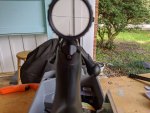Serious question, did you not read it, or did you not understand it?
A scope's EP corresponds to your own pupil, which dilates from about 2mm in bright sunlight to perhaps 7mm in the dark. If your scope's exit pupil is smaller than your pupil, it can't transmit all the light you can use. If it's larger, the extra rim of light bounces off your iris and never enters your pupil to stimulate your retina. Wasted light. But an excess diameter of exit pupil does give your eye more room to wander around in without showing edge blackout, so that's something.
The reason a 30mm main tube scope isn't inherently brighter than a 1-inch scope is because both carry internal lenses much larger than 7mm, so there is no loss of light through either. The reason some 30mm scopes appear to project brighter views is probably because they were built with the absolute finest materials and effective light transmission (how much light the scope passes through) determines brightness, is a product of the number of air-to-glass surfaces in the scope (the fewer the better) and the anti-reflection coatings on those lenses. (The more the better.)
It never ceases to amaze me how some people choose to simply be an ass over the Internet.
" So what, then, are the advantages of a 30mm scope tube? The walls can be made thicker for added strength and durability or the internal lenses can be made slightly larger, which increases optical performance simply because larger lenses always perform better than smaller ones, all else being equal"
It's simply easier to get things right with a bigger tube.



